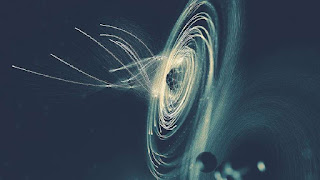Micro-Singularity Grenades
Fans
of the IX Series will be aware that I like to base the futuristic tech you read
about in the pages of The IX – Exordium of Tears – and later this year,
Prelude to Sorrow – on the very
latest theoretical science to emerge from the many research laboratories
scattered around the world.
Five
years ago, I read an interesting paper in Scientific
America Magazine regarding the possibility of creating an artificial black
hole for use as a power source, something that the wonderful world of science
fiction had already surmised a number of years before.
(Star Trek buffs will remember the Romulans were purported to power their starships with gravity banded micro singularities).
(Star Trek buffs will remember the Romulans were purported to power their starships with gravity banded micro singularities).
At
the time, I was still in the world building phase for the IX, and, imagining
the various aspects of technology the futuristic Ardenese race might employ, I thought...
“Hey, what if there was such a thing as a micro-singularity grenade?” a weapon
capable of generating a temporary, limited field of crushing gravity, the
implosive/explosive kinetic energy of which would be sufficient to destroy
anything within its effective radius. (Just the thing our protagonists would
need to take care of the pesky superhuman Horde ogres).
Well,
as readers now know, Mac McDonald and his Special Forces team of kick-ass
commandos went on to use singularity grenades to great effect in the ensuing
adventures of The IX, and such weapons went on to become part of an arsenal
they used in their efforts to turn the tide against a relentless enemy.
Ah,
the stuff of science fiction eh?
Or
is it?
Take
a quick look at these short excerpts from the SLAC National Accelerator
Laboratory at Stanford University along with
extracts from Galaxy & Nature magazines:
******
******
Researchers
at the SLAC National Accelerator Laboratory have managed to produce an extreme
physical object – a molecule that attracts more electrons than it can
keep until it explodes.
This
object, dubbed a molecular black hole, caught researchers by surprise as they
weren’t expecting something quite so intense and astronomers and scientists are
now beginning to suspect that this rather stolid source of many a science
fiction story may, in fact, be science fact.
When scientists at the Department of
Energy's SLAC National Accelerator Laboratory focused the full intensity of the
world's most powerful X-ray laser on a small molecule, the pulse stripped all
but a few electrons out of the molecule's biggest atom from the inside out,
leaving a void that started pulling in electrons from the rest of the molecule,
like a black hole gobbling a spiraling disk of matter.
Within
30 femtoseconds (millionths of a billionth of a second), more than 50 electrons
from the rest of the molecule came rushing in, which quickly led to the
explosive demise of the molecule.
While
scientists have seen similar behavior before when this experiment was attempted
with less intense beams or isolated atoms, they've not seen it to this
magnitude. The molecular black hole is not just astonishing as a new discovery,
but it provides clues on how X-ray lasers affect molecules. This is important
because we use X-ray lasers to study how individual biological systems work.
“For any type of experiment you do
that focuses intense X-rays on a sample, you want to understand how it reacts
to the X-rays. This paper shows that we can understand and model the radiation
damage in small molecules, so now we can predict what damage we will get in
other systems.” experiment
leader Daniel Rolles, of Kansas State University, said in a statement.
“We think the effect was even more important in the larger
molecule than in the smaller one, but we don't know how to quantify it yet. We
estimate that more than 60 electrons were kicked out, but we don't actually
know where it stopped because we could not detect all the fragments that flew
off as the molecule fell apart to see how many electrons were missing. This is
one of the open questions we need to study.” lead author Artem Rudenko added.
******
******
The
power of the laser has allowed the study of reactions
like photosynthesis in never-seen-before detail, and it remains an
incredibly powerful instrument. The X-ray pulses are 100 times more intense
than if you concentrate all the sunlight we receive on Earth onto a single
thumbnail.
All that power from such a tiny thing.
Why? Because the iodine atom – which had a strong positive charge after losing
most of its electrons – continued to suck in electrons from neighboring carbon
and hydrogen atoms, and those electrons were also ejected, one by one, creating
a level of damage and disruption that's not only higher than would normally be
expected, but significantly different in nature.
Amazing, isn’t it, to think that a
make-believe device might one day have a basis to zap alien bad guys?.
Of course, this raises a perplexing
question. Do sci-fi enthusiasts like myself get our ideas from innovative
breakthroughs in the field of scientific discovery...or are there researchers
out there secretly getting inspiration from science fiction novels?
Mind boggling.
As a well know series always reminds us:
“This has all happened before, and it will all happen again.”



